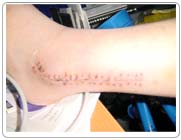What is it?
Your ankle is broken. The bones are not in their proper place. If the bones are left to heal in this position, you may develop arthritis in your ankle. Your ankle is broken in such a way that you cannot be treated in just a plaster cast. Fractured means broken. There is no difference in severity between a fractured bone and a broken bone.
The Operation
 You will be given a general anaesthetic so that you will be completely asleep. A cut on one or both sides of your ankle is made. The pieces of your broken bone are brought together. Special screws and plates are used to hold the pieces in place while the bone heals. The skin wound is then closed up with stitches. A temporary plaster cast is put on your leg. The plaster extends from just below your knee to your toes.
You will be given a general anaesthetic so that you will be completely asleep. A cut on one or both sides of your ankle is made. The pieces of your broken bone are brought together. Special screws and plates are used to hold the pieces in place while the bone heals. The skin wound is then closed up with stitches. A temporary plaster cast is put on your leg. The plaster extends from just below your knee to your toes.
Any Alternatives
If you leave things as they are, the ankle will be painful and will get arthritis in a year or more.
Before the operation
You will have come to the hospital as an emergency. You need to let the doctors and nurses know about your general health, past illnesses, and drug treatment. Arrangements will be made for you to have the operation done within 24 hours or so of the injury.
After - In Hospital
The physiotherapist will help you to get out of bed with crutches once the swelling of the ankle has gone down. The physiotherapist will teach you how to walk and how to go up and down stairs with crutches. The surgeon who performs your operation will give you instructions about when you may start to move your ankle. Some surgeons prefer to get your ankle moving in hospital before putting your ankle in a plaster cast and sending you home. Other surgeons will not get your ankle moving before sending you home in a plaster cast. For the first two weeks after your operation, you should rest with your leg elevated when your are not walking. This is because your ankle will tend to swell within the plaster when you are upright. You must not get your plaster cast wet. You will be in hospital two or three nights after the operation. You will have an x-ray of your ankle before you go home. You will be given an appointment to come to the orthopaedic out patient department ten days or so after your operation. Your stitches will then be removed. You will be given an appointment to visit the orthopaedic out patient department to have check X-rays. You will be in a plaster cast for approximately six weeks. The nurses will advise about sick notes, certificates etc.
After - At Home
When you go home, you will be able to move around the house and manage stairs. You will not be able to go shopping for the first few weeks after you go home. Please make arrangements for friends or family to shop for you. Your ankle will continue to improve for up to twelve months. Looking after a plaster cast. Do not press on your plaster for 48 hours. Do not let your plaster cast get wet. Do not cut or bang your plaster. Do not put anything down the inside of your plaster (e.g. coins). Do not use anything to scratch under your plaster. Come back to the hospital if: you have pins and needles or numbness in your toes. you cannot move your toes. your toes go blue. your toes become very swollen. you have severe pain. Come back to see the plaster technician if: the plaster cracks the plaster becomes soft the plaster is loose. How soon you can return to work depends on your job. If you sit whilst at work, you will be able to return to work two or three weeks after your operation. This also depends on you being able to get to work. If your job is manual you will be unable to work for at least three months. You may play light sports twelve weeks after your operation. You may not play contact sports until you have been told that the break has soundly healed. When you start playing, you will not be able to play for as long as normal. Your leg will ache at the end of a game. Your leg will continue to improve for up to twelve months. The screws and plates do not have to be removed. If they become uncomfortable, they can be removed eighteen months or more after your operation. Physiotherapy will be arranged for you.
Possible Complications
Wound infection sometimes happens. You will be given antibiotics to prevent this. You can develop a blood clot in the veins of your calf. This is called a Deep Vein Thrombosis (D.V.T.). A combination of medicine and compression stockings will be used to try to prevent this. Occasionally the fracture does not heal. If this occurs you will need another operation. If it is impossible to put the bones together so that the joint surface is smooth, you may develop arthritis in your ankle.
Advanced Reproductive Technology
- In Vitro Fertilisation (IVF)
- Intracytoplasmic Sperm Injection (ICSI)
- Donor egg and embryo programs
- In Vitro Fertilisation (IVF)
- Pre-implantation genetic diagnosis (PGD)
- Surrogacy programs
Dental Videos





